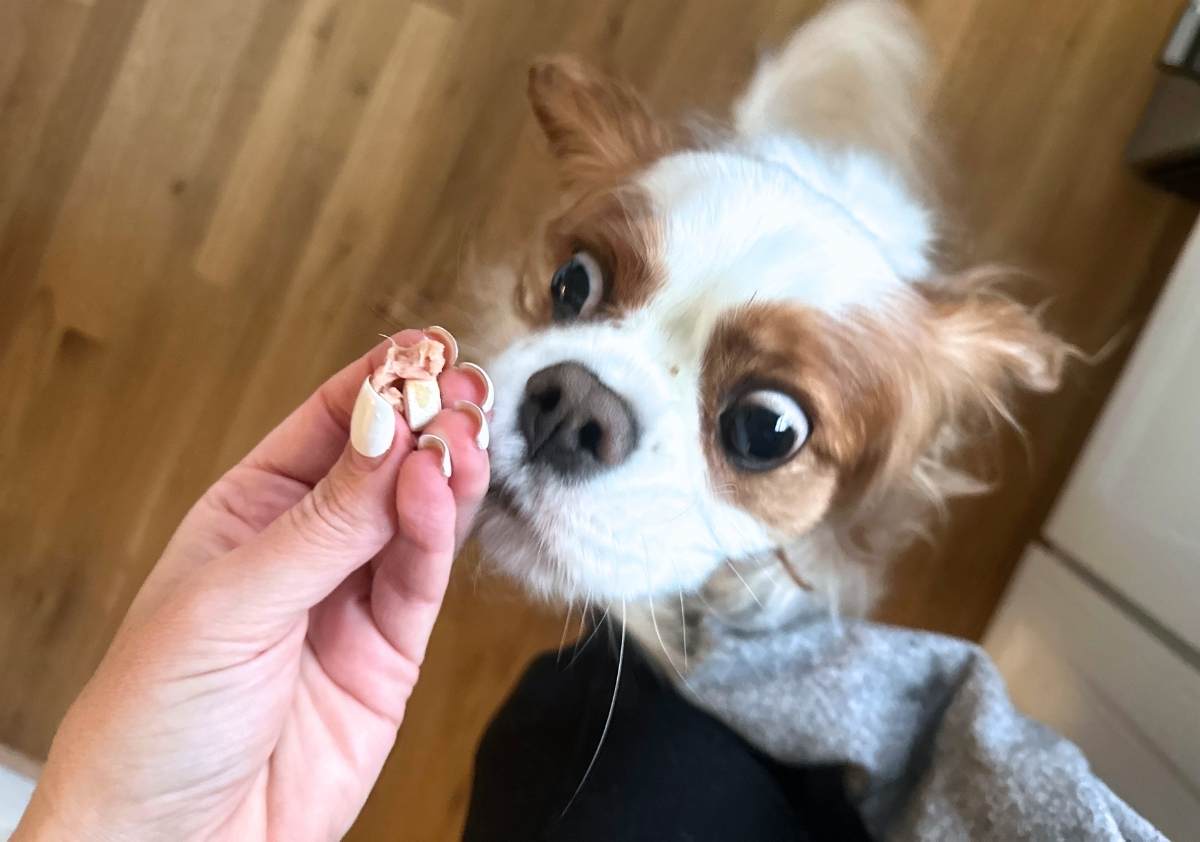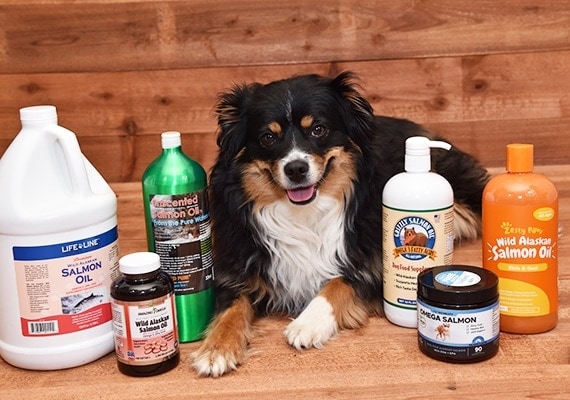To keep the lights on, we receive affiliate commissions via some of our links. Our review process.
Thiamine is a very common additive to dog food. In fact, if you look on the ingredients of your current dog food, you’ll probably find it listed.
But what is thiamine, and is it safe for your dog?
Today we explore what thiamine is, why it’s in your dog’s food and the role it plays.
What is thiamine?
Thiamine is a B vitamin.
B vitamins are a collection of vitamins that are essential to your dog’s health. B vitamins keep your pup’s body functioning correctly – without them, your dog would suffer serious health issues.
The B vitamins are:
- Thiamine (Vitamin B1)
- Riboflavin (Vitamin B2)
- Niacin (Vitamin B3)
- Pantothenic Acid (Vitamin B5)
- Pyrdoxin (Vitamin B6)
- Biotin (Vitamin B7)
- Folic Acid (Vitamin B9)
- Cobalamin (Vitamin B12)
You’ll have most likely know thiamine by its more common name – Vitamin B7.
Thiamine can also be spelled as thiamin, without the E on the end.
However, on the ingredients list, you’ll see it written as either thiamine mononitrate or thiamine hydrochloride. I’ll explain the difference between the two in a moment.
Thiamine is found in foods such as meat, fish, beans, lentils and nuts. However, your dog’s most common source of thiamine will likely be from their pet food – as an added ingredient.
How does thiamine help your dog?
As part of a balanced diet, thiamine actually has very similar benefits to your dog’s health as it does yours and mine.
There are three key benefits that thiamine offers:
1. Supports digestion
Thiamine helps your dog to digest carbohydrates. Many of the enzymes in your dog’s body require thiamine to break down carbohydrates and produce energy.[1]
2. Supports DNA production
Thiamine is also used as to create the building blocks (nucleotides) of your dog’s DNA – helping your dog grow muscles and maintain a healthy weight.
3. Supports brain function
Thiamine is helps to maintain your dog’s brain, nervous system and motor skills – keeping your dog sharp and agile.
As you can see, thiamine is a pretty important vitamin. If your dog doesn’t get enough, it can lead to a thiamine deficiency. In extreme cases, a thiamine deficiency can be fatal.
That’s why the dietary recommendations for dogs include substantial amounts of thiamine.[2]
Why is thiamine added to dog food?
As I discussed earlier, thiamine is found in meat, fish, grains. beans and lentils.
It’s very likely that your dog food has these as ingredients. For instance, brown rice and salmon are both high in thiamine and are common ingredients in dog food.
But even if your dog food contains ingredients that are high in thiamine, it doesn’t mean your dog food contains enough to keep your dog healthy.
You see, when dog food is manufactured, there are a wide range of factors that can impact how much of a vitamin or mineral remains in the food.
Cooking time, cooking method, temperature, light, and air can all reduce the total vitamin content of your dog food.
Thiamine in particular breaks down with heat.[3]
And that’s not a good thing. A deficiency in these vitamins and minerals can cause long-term health issues for your dog.
That’s why dog food manufacturers add thiamine back into the dog food as a separate ingredient – to ensure your dog has enough to meet his daily requirements.
There are two types of thiamine that are added to dog food:
1. Thiamine mononitrate
The most common type of thiamine used as an ingredient dog food. Thiamine mononitrate is a stabilized version of thiamine, to stop it from degrading. It also has the added benefit of resisting moisture – making it a suitable ingredient for dry dog food.
2. Thiamine hydrochloride
Another stabilized version of thiamine, to stop degradation. Thiamine hydrochloride does not have the same moisture resistance as thiamine mononitrate.[4]
By feeding your pup a dog food that has thiamine as an ingredient, you can be confident you are meeting your dog’s daily thiamine requirements.
Interestingly, multiple studies have shown that home-made or raw diets often don’t contain enough thiamine.[5] [6]
Is thiamine safe for dogs?
Yes, the amount of thiamine added to dog foods is considered safe for dogs.
The AAFCO recommends a minimum of 0.56 mg of thiamine per 1000 calories for all life stages – growth, reproduction and adult maintenance.
However, AAFCO does not have an upper limit for how much thiamine should be included in dog food.
Not that this is an issue…
Waaaaaay back in 1987, the NRC showed that a thiamine up to a whopping 1,000 times the requirement are safe for most animal species.[7]
You shouldn’t be concerned about your dog overdosing on the small amount of thiamine in his food – even if your dog was to eat the entire bag of kibble![8]
Once your dog’s body reaches a certain amount of thiamine, he will no longer store the vitamin in his body.
But excess thiamine doesn’t build up to toxic levels. Because thiamine is water soluble, it leaves the body each time your dog poops or pees.
This is part of the reason why your dog should consistently eat food with thiamine in it – to replenish his thiamine levels.
Does thiamine trigger allergies?
No. Thiamine is not known to trigger any allergies in dogs.
Are there any additional studies on thiamine?
Most of the studies on thiamine in dogs have been used to determine the correct nutrition recommendations and examine deficiency.
One interesting study focused on a pack of sled dogs that were fed only carp during their sledding season.
When two dogs became severely ill, Ontario Veterinary College discovered that they suffered severe thiamine deficiency after only 6 months off their regular diet.
Luckily, the other dogs in the pack were able to be treated and supplemented with thiamine, after which they became healthy enough to work again![9]
What are the regulations regarding adding thiamine to dog food?
The FDA allows thiamine to be added to food under the following regulations:
Thiamine mononitrate
582.5878 (GRAS) – Section 184.1878 (title 21)
Thiamine hydrochloride
582.5875 (GRAS) – Section 184.185 (Title 21)
Under the FDA regulations, thiamine can be used as an additive under the GRAS notification. As long as good manufacturing processes are used, thiamine is considered a safe ingredient.[10]
The AAFCO mandates that when thiamine (any form) is displayed on a guaranteed analysis, it is to be measured in milligrams per pound.
Thiamine has also been assigned International Feed Numbers:
- Thiamine mononitrate – IFN 7-04-829
- Thiamine hydrochloride – IFN 7-04-828
Are there similar ingredients to thiamine?
No, there are no similar ingredients that can replace thiamine. Thiamine is an essential vitamin required for your dog’s well being.
Additional resources: Association of American Feed Control Officials. 2021 Official Publication. Association of American Feed Control Officials Inc., 2021.
Tagged With:

